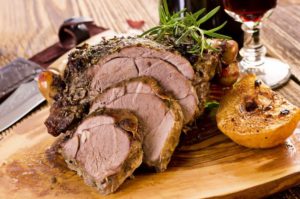 Roast lamb is now commonly eaten throughout the UK, a great tradition in a similar way to roast beef, and a centuries old favourite which is still going strong today.
Roast lamb is now commonly eaten throughout the UK, a great tradition in a similar way to roast beef, and a centuries old favourite which is still going strong today.
Influences from around the world have led to an increase in its popularity and with Welsh lamb regarded as one of the World’s best, this cut continues to grow in popularity across all continents.
History of the Sunday Roast
The Sunday roast originated in England as a meal to be eaten after church on Sunday whether it be pork, mutton, beef or a fowl. Eating a large meal following church services is common in many European continents as with other Christian countries.
Interestingly, in the late 1700s during the industrial revolution in the United Kingdom, families would place a cut of meat into the oven as they prepared for church. They would then add in vegetables such as potatoes, turnips and parsnips before going to church on a Sunday morning. When they returned from the church the dinner was all but ready. The juices from the meat and vegetables were used to make a stock or gravy to pour over the dinner. A practice we heartily agree with!
The tradition of eating lamb at Easter has its roots in early Passover observances before the birth of Christianity. According to the biblical Exodus story, the people of Egypt suffered a series of terrible plagues, including the death of all firstborn sons. Jews painted their doorposts with sacrificed lamb’s blood so that God would “pass over” their homes while carrying out the punishment. Accustomed to eating roast lamb on Passover, Jews who converted to Christianity continued the tradition at Easter. Additionally, Christians refer to Jesus as the “Lamb of God,” so it makes sense that the food shows up at the Easter table. On a less symbolic note, lamb would have been one of the first fresh meats available after a long winter with no livestock to slaughter.
Why Mint Sauce?
To partner meat with herbs and fruit was common in medieval times, and as there were no actual defined sweet and savoury foods back then so unusual pairings were common place.
One theory behind the pairing of mint with lamb is a legacy of the roast lamb and bitter herbs eaten by the Israelites on the eve of their Exodus from Egypt.
Another is more straightforward, it was used to counterbalance the strong flavour and aroma of Mutton which was originally eaten back in the day. There is no doubt that the sweet aromas of the mint work perfectly well with roast lamb and is enjoyed throughout the UK
Choosing the Right Joint
Joints taken from the lamb saddle are the equivalent to the beef sirloin, fillet and forerib; these command the highest price point but are truly worth it, cuts such as best end (rack) French trimmed, bone and rolled loin or saddle are real centre pieces for any dinner table.
Other joints which are more popular on a regular basis and less expensive are leg, both bone in or butterflied plus individual rump roast portions.
Other less common joints we feature are the shoulder joint again bone in or bone out which are best pot roasted.
Our Favourite Roast Lamb Joints
The butchers at Hugh Phillips Gower Butcher have come up with their top four favourite lamb cuts which we sell, along with many others, at shop in Swansea Market and online at www.bestonlinebutcher.co.uk. Our lamb is locally sourced from the Gower and the surrounding area, where these lambs graze freely providing excellent flavour and nutritional value. Each of these cuts is great for a Sunday roast or any other meal with family and friends.
- Half Rolled Shoulder of Lamb is a joint cut from the whole shoulder. Our qualified butchers will remove the bones and hand roll this joint and is a perfect choice for the smaller family serving 2 – 4 people. This easy carving rolled shoulder join.t
- Fillet of Lamb is cut from the top of the leg of lamb. At Hugh Phillips we “Welsh Dress” our Fillets of Lamb to provide a joint which will self baste whilst roasting. Served on the bone for extra flavour.
- We also “Welsh Dress” our Half Legs of Lamb to provide a joint which will self baste whilst roasting. Served on the bone for extra flavour.
- Rack of Lamb is great for a dinner party or for a special occasion. Our qualified butchers hand cut these three rib racks from the “Best End” of the loin and hand trim to expose the rib bones.
Checking Your Lamb is Properly Cooked
The best way is to check if your lamb is properly cooked is to press the thickest part of the joint with your index finger. If the joint is soft to touch it will be rare, the firmer to the touch the more well done the joint will be cooked.
You can also test with a thermometer which should be very clean before probing. Simply dip the needle into boiling water for 5 seconds before and after immersing in the joint. Pierce the needle into the centre of the joint and hold for a few seconds, the temperature should read a minimum of 50°C before removing from the oven.
Another option is to test with tongs. Gently prod the roast: rare is very soft, medium rare is soft, medium is springy but soft, medium well is firm and well done is very firm.


John Thomas
Buy lamb from the best butcher in Swansea Market. To sell the best they buy the best, but to eat the best you also have to buy the best. Where cometh the best lamb in Swansea Market, well Hugh Phillips Butchers of Swansea